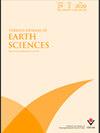努比亚-阿拉伯-欧亚板块活动相互作用带断层和块体作用的新大地测量约束与分布应变
IF 1.1
4区 地球科学
Q3 GEOSCIENCES, MULTIDISCIPLINARY
引用次数: 1
摘要
我们对努比亚-阿拉伯-欧亚板块相互作用区域内GNSS观测数据的统一处理得出的现今运动和变形进行了广泛的观察。我们提出的新观测提供了~29%的速度测定数量增加,平均站间距从~76 km减少到~39 km,并且速度不确定性有所改善(在~126,000 km 2中,以北安纳托利亚断层和东安纳托利亚断层为边界,内部速度差<0.5 mm/年,表明应变率< ~1.5纳米应变/年)。这种简化方法得到的受大地测量约束的断层滑动速率与地质速率相当,表明主要断层控制了该地区最近的地质演化(即5-10迈拉)。现今的变形模式,包括越来越快的向希腊海沟移动,以及中新世早期所有主要地中海盆地几乎同时开放,努比亚-欧亚大陆辐合速度减慢,支持了爱琴海下俯冲的努比亚板块的沉没和回滚是造成安纳托利亚-爱琴海地区现今运动和内部变形的主要机制的概念模型。本文章由计算机程序翻译,如有差异,请以英文原文为准。
New geodetic constraints on the role of faults and blocks vs. distribute strain in the Nubia-Arabia-Eurasia zone of active plate interactions
: We present a broad view of present-day motions and deformations derived from uniform processing of GNSS observations within the Nubia-Arabia-Eurasia zone of plate interaction. The new observations we present provide a ~29% increase in the number of velocity determinations, a reduction in average station spacing from ~76 km to ~39 km, and an improvement in velocity uncertainties (for <1 mm/year), from 180 to 578 sites compared to our prior published solution (Reilinger et al., 2006). We use these new constraints to better evaluate the role of faults and blocks in controlling the character of continental deformation within the zone of plate interactions. Simple elastic block models show that internal deformation of the region occurs in large part on mapped, seismically active fault systems, indicating elastic behavior of the seismogenic crust (above ~15 km). For example, eastern central Anatolia, an area of > ~126,000 km 2 , bounded by the North and East Anatolian Faults exhibits internal velocity differences of <0.5 mm/year, indicating strain rates of < ~1.5 nanostrain/year. Geodetically constrained fault slip rates obtained from this simplified approach are comparable to geologic rates, indicating that major faults have controlled the recent geologic evolution of the region (i.e. 5–10 Myr). The pattern of present-day deformation, including increasingly fast motions towards the Hellenic trench, and the roughly simultaneous opening of all the major Mediterranean basins in the early Miocene with the slowing of the Nubia-Eurasia convergence, support conceptual models that foundering and rollback of the subducted Nubian slab beneath the Aegean is the primary mechanism responsible for present-day motion and internal deformation of the Anatolian-Aegean region.
求助全文
通过发布文献求助,成功后即可免费获取论文全文。
去求助
来源期刊

Turkish Journal of Earth Sciences
地学-地球科学综合
CiteScore
2.40
自引率
10.00%
发文量
6
审稿时长
6 months
期刊介绍:
The Turkish Journal of Earth Sciences is published electronically 6 times a year by the Scientific and Technological Research
Council of Turkey (TÜBİTAK). It is an international English-language journal for the publication of significant original recent
research in a wide spectrum of topics in the earth sciences, such as geology, structural geology, tectonics, sedimentology,
geochemistry, geochronology, paleontology, igneous and metamorphic petrology, mineralogy, biostratigraphy, geophysics,
geomorphology, paleoecology and oceanography, and mineral deposits. Contribution is open to researchers of all nationalities.
 求助内容:
求助内容: 应助结果提醒方式:
应助结果提醒方式:


